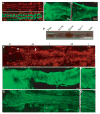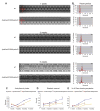Dystrophin deficiency in Drosophila reduces lifespan and causes a dilated cardiomyopathy phenotype
- PMID: 18221418
- PMCID: PMC2840698
- DOI: 10.1111/j.1474-9726.2008.00367.x
Dystrophin deficiency in Drosophila reduces lifespan and causes a dilated cardiomyopathy phenotype
Abstract
A number of studies have been conducted recently on the model organism Drosophila to determine the function of genes involved in human disease, including those implicated in neurological disorders, cancer and metabolic and cardiovascular diseases. The simple structure and physiology of the Drosophila heart tube together with the available genetics provide a suitable in vivo assay system for studying cardiac gene functions. In our study, we focus on analysis of the role of dystrophin (Dys) in heart physiology. As in humans, the Drosophila dys gene encodes multiple isoforms, of which the large isoforms (DLPs) and a truncated form (Dp117) are expressed in the adult heart. Here, we show that the loss of dys function in the heart leads to an age-dependent disruption of the myofibrillar organization within the myocardium as well as to alterations in cardiac performance. dys RNAi-mediated knockdown in the mesoderm also shortens lifespan. Knockdown of all or deletion of the large isoforms increases the heart rate by shortening the diastolic intervals (relaxation phase) of the cardiac cycle. Morphologically, loss of the large DLPs isoforms causes a widening of the cardiac tube and a lower fractional shortening, a phenotype reminiscent of dilated cardiomyopathy. The dilated dys mutant phenotype was reversed by expressing a truncated mammalian form of dys (Dp116). Our results illustrate the utility of Drosophila as a model system to study dilated cardiomyopathy and other muscular-dystrophy-associated phenotypes.
Figures





Similar articles
-
Mechanical and non-mechanical functions of Dystrophin can prevent cardiac abnormalities in Drosophila.Exp Gerontol. 2014 Jan;49:26-34. doi: 10.1016/j.exger.2013.10.015. Epub 2013 Nov 12. Exp Gerontol. 2014. PMID: 24231130 Free PMC article.
-
Cardiac phenotype of Duchenne Muscular Dystrophy: insights from cellular studies.J Mol Cell Cardiol. 2013 May;58:217-24. doi: 10.1016/j.yjmcc.2012.12.009. Epub 2012 Dec 20. J Mol Cell Cardiol. 2013. PMID: 23261966 Free PMC article. Review.
-
Dystrophin Deficiency Causes Progressive Depletion of Cardiovascular Progenitor Cells in the Heart.Int J Mol Sci. 2021 May 10;22(9):5025. doi: 10.3390/ijms22095025. Int J Mol Sci. 2021. PMID: 34068508 Free PMC article.
-
Cardiac dysfunction and pathology in the dystrophin and utrophin-deficient mouse during development of dilated cardiomyopathy.Neuromuscul Disord. 2012 Apr;22(4):368-79. doi: 10.1016/j.nmd.2011.07.003. Epub 2012 Jan 21. Neuromuscul Disord. 2012. PMID: 22266080
-
Molecular basis of hypertrophic and dilated cardiomyopathy.Tex Heart Inst J. 1994;21(1):6-15. Tex Heart Inst J. 1994. PMID: 8180512 Free PMC article. Review.
Cited by
-
A dual role for integrin-linked kinase and β1-integrin in modulating cardiac aging.Aging Cell. 2014 Jun;13(3):431-40. doi: 10.1111/acel.12193. Epub 2014 Jan 9. Aging Cell. 2014. PMID: 24400780 Free PMC article.
-
The evolutionarily conserved RNA binding protein SMOOTH is essential for maintaining normal muscle function.Fly (Austin). 2009 Oct-Dec;3(4):235-46. doi: 10.4161/fly.9517. Epub 2009 Oct 14. Fly (Austin). 2009. PMID: 19755840 Free PMC article.
-
Genetic manipulation of cardiac ageing.J Physiol. 2016 Apr 15;594(8):2075-83. doi: 10.1113/JP270563. Epub 2015 Jul 14. J Physiol. 2016. PMID: 26060055 Free PMC article. Review.
-
BKCa (Slo) Channel Regulates Mitochondrial Function and Lifespan in Drosophila melanogaster.Cells. 2019 Aug 21;8(9):945. doi: 10.3390/cells8090945. Cells. 2019. PMID: 31438578 Free PMC article.
-
Huntington's disease induced cardiac amyloidosis is reversed by modulating protein folding and oxidative stress pathways in the Drosophila heart.PLoS Genet. 2013;9(12):e1004024. doi: 10.1371/journal.pgen.1004024. Epub 2013 Dec 19. PLoS Genet. 2013. PMID: 24367279 Free PMC article.
References
-
- Adams MD, Celniker SE, Holt RA, Evans CA, Gocayne JD, Amanatides PG, Scherer SE, Li PW, Hoskins RA, Galle RF, George RA, et al. The genome sequence of Drosophila melanogaster. Science. 2000;5461:2185–2195. - PubMed
-
- Bassett D, Currie PD. Identification of a zebrafish model of muscular dystrophy. Clin Exp Pharmacol Physiol. 2004;8:537–540. - PubMed
-
- Bessou C, Giugia JB, Franks CJ, Holden-Dye L, Segalat L. Mutations in the Caenorhabditis elegans dystrophin-like gene dys-1 lead to hyperactivity and suggest a link with cholinergic transmission. Neurogenetics. 1998;2:61–72. - PubMed
-
- Bier E. Drosophila, the golden bug, emerges as a tool for human genetics. Nat Rev Genet. 2005;1:9–23. - PubMed
-
- Bier E, Bodmer R. Drosophila, an emerging model for cardiac disease. Gene. 2004;342:1–11. - PubMed
Publication types
MeSH terms
Substances
Grants and funding
LinkOut - more resources
Full Text Sources
Molecular Biology Databases
Research Materials

